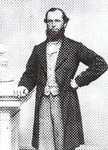Keywords: Abolitionist
Item 102842
Remarks on board the Julia E. Arey, 1860
Contributed by: Maine Historical Society Date: 1860-11-05 Location: Thomaston; Jefferson Media: Ink on paper
Item 6079
Hannah Farmer, Eliot 1823-1891
Contributed by: Eliot Baha'i Archives Date: circa 1880 Location: Eliot Media: Photographic print
Exhibit
Mainers, like residents of other states, had differing views about slavery and abolition in the early to mid decades of the 19th century. Religion and economic factors were among the considerations in determining people's leanings.
Exhibit
Reuben Ruby: Hackman, Activist
Reuben Ruby of Portland operated a hack in the city, using his work to earn a living and to help carry out his activist interests, especially abolition and the Underground Railroad.
Site Page
Life on a Tidal River - Bangor and Social Reform Movements of the 1800s-1900s
"… and Abolitionist Amory Battles X Brewer Abolitionist John Holyoke X Bangor Abolitionist George Thatcher Thatcher was the first Secretary…"
Site Page
Maine's Road to Statehood - The Missouri Compromise: A Moral Dilemma
"Despite an initial pushback by leading abolitionists and organizers in Maine, most statesmen decided that immediate independence was more important…"
Story
We Are An Ordinary Family
by Catherine
Maine's abolitionists offer an answer to my questions about my family's experiences.
Lesson Plan
Longfellow Studies: "The Slave's Dream"
Grade Level: 6-8, 9-12
Content Area: English Language Arts, Social Studies
In December of 1842 Henry Wadsworth Longfellow's Poems on Slavery was published. "The Slave's Dream" is one of eight anti-slavery poems in the collection. A beautifully crafted and emotionally moving poem, it mesmerizes the reader with the last thoughts of an African King bound to slavery, as he lies dying in a field of rice. The 'landscape of his dreams' include the lordly Niger flowing, his green-eyed Queen, the Caffre huts and all of the sights and sounds of his homeland until at last 'Death illuminates his Land of Sleep.'











